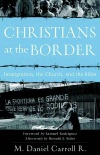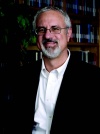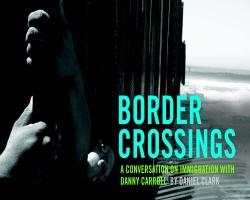Danny Carroll had just returned from several weeks in Israel, Jordan, England, Bolivia and Guatemala when we sat down together in his office at Denver Seminary. He claims America and Guatemala as home, having grown up bilingual and bicultural.
This varied experience permeates his academic, theological and biblical work, including his most recent book, Christians at the Border.
Immigration—forced and unforced, historic and contemporary—is an unavoidable part of American life. In centuries past, ministries were able to ignore this phenomenon; but immigration and immigrants no longer are isolated, segregated or subjugated in the way they were during the founding centuries of our nation. The world is everywhere around us. Our neighborhoods, our churches, our schools and even our families are more diverse than ever before. It is this phenomenon (read: this beautiful, humble and creative kingdom opportunity) that should lead youth ministers to stand up and take notice of the work of scholars and practitioners like Danny Carroll.
“It’s important to be aware of U.S. immigration because everyone in this country is a son, daughter or grandchild of an immigrant,” says Carroll. It should be obvious to us that Northern Europeans weren’t the first to inhabit the New World. There are those who would choose to freeze the American identity in North Atlantic Protestantism, but Carroll says, “National identity is not a snapshot; it’s a motion picture.” It’s moving. It’s dynamic. The American identity is ever changing.
Identity and Sub-Cultures
The question of identity is prevalent in Carroll’s Christians at the Border. Repeatedly, it came up in our conversation. There are tens of millions of Hispanics in America now, and with them, as Carroll says, “There is a Christian Hispanic subculture that Anglos aren’t even aware of.” There are Spanish-language youth ministry magazines and conferences (check out www.xtremoweb.com and www.convencionliderazgo.com). Youth ministers in America need to know this. “Majority culture youth leaders need to prepare their youth for a country with a growing Hispanic culture that’s all around them. It’s too easy to just focus on the Anglo suburbanite.”
One-half of the population of Latin America is under 20 years old. (Think about it. If half of your church were under 20, you’d have job security … albeit maybe no budget.)
Things are different in the global south. Carroll says, “America is aging.” Boomers are retiring, and the economic prospects facing today’s young families don’t indicate another birth boom in the near future. Therefore, we must consider youth culture if we are going to have an informed and relevant discussion about immigration. We must talk about immigration if youth ministry in America is on the table. These two issues go hand-in-hand.
Within this Hispanic youth subculture, young people are asking themselves identity-forming questions. Who are we? What do I do here? Carroll discusses this feature of the immigrant psyche, which he calls “negotiation” in Christians at the Border. I asked him to explain.
“The negotiation piece is about dress,” he said. “It’s about food. It’s interesting for me. Do we follow the Broncos or the Rapids? Do we follow American football? Do we go to a Hispanic church, or do we put our youth into an Anglo suburban church so they can get inculturated?”
These options must be negotiated with the prevailing culture. Carroll says, “The majority culture doesn’t have to negotiate these spaces. It’s not about the color of their skin or why they speak with an accent.” For Hispanic youth in America, these questions are present day after day.
This negotiation fails at times, which saddens Carroll. “For some Hispanic youth, because they sense the racism and disrespect, they are ashamed and try too hard to be Americans, to imitate and mimic American youth culture. It’s usually not healthy. It’s usually what they see on MTV.”
(Multi)Culturally Aware
In light of this phenomenon, it is not enough to make our young people culturally aware. “Make them multiculturally aware,” says Carroll. “That’s the world. Teenagers today have gone to multi-ethnic schools. Young people have gone to college and roomed with a person of a different color. Diversity does not surprise a young person, while the older generations are used to a more monochrome, homogenous reality.”
This awareness starts as interest, curiosity and fascination. Ethnic foods. Latin dancing. Mission trips! Some of this, of course, is, as Carroll says, “manufactured.” Take for example a normal conversation when deciding where to go for dinner. What are you in the mood for? Italian? Mexican? Chinese? Indian? This surface-level engagement with diversity is a starting point, but it is only that. It must be directed and deliberate to move beyond mere awareness to engagement, embracing, and ultimately to the unity of which the gospel speaks.
The first step is to listen to people who are different than you are. It could take our lifetime to get this one. The next step is more difficult. This is where the breakdown often occurs. Carroll says, “We must be willing to entertain the presence and reality of different lifestyles.” The third step is nearly impossible in the present geopolitical and cultural landscape. We must embrace these differences as valid and valuable. Take a deep breath. It’s possible. (Neither Jew nor Greek, male nor female, slave nor free … sound familiar?)
What’s Next?
Carroll says, “There is a world out there in desperate need of youth workers who are contextualized.” This multi-cultural world starts right outside our church doors. No, it’s closer than that. It starts in our pews (or our multi-purpose rooms). Carroll, though he is well-connected in Latin-American Christian circles, is not aware of a single Latin-American seminary that has a youth ministry focus. Youth workers in Latin America and in the Hispanic subcultures in America need partners, sponsors, mentors and teachers—all with an attitude of service, humility and mutuality. Majority culture youth leaders need to help prepare and resource youth workers in minority cultures. Additionally, Carroll says, “Majority culture youth leaders need to engage and minister to Hispanic youth while preparing majority culture youth for the realities of the 21st century.”
According to Carroll, “The thing is to expose and inform. The way to do that is to get materials into people’s hands and maybe even do a Bible study.” Reading Christians at the Border together is a great place to start. The second step is for majority culture youth groups to “hook up with Hispanic churches and begin to meet some youth from other cultures.”
Is this possible? What if we could engage and embrace? Listen and learn? Serve and celebrate together? Carroll says we need to move forward in a “constructive, Christian way.” What if your youth group could teach your community how to live not only with diversity but in diversity? Then I think we’d be on to something. Our message would have weight. Our kids would have a purpose. Our cities would be healthier. The stranger would find a home. The lonely would find a family. Sounds like the gospel to me. Sounds like a beautiful, humble and creative kingdom opportunity.






